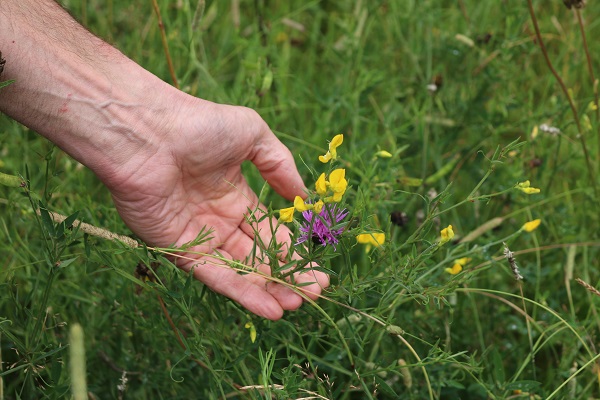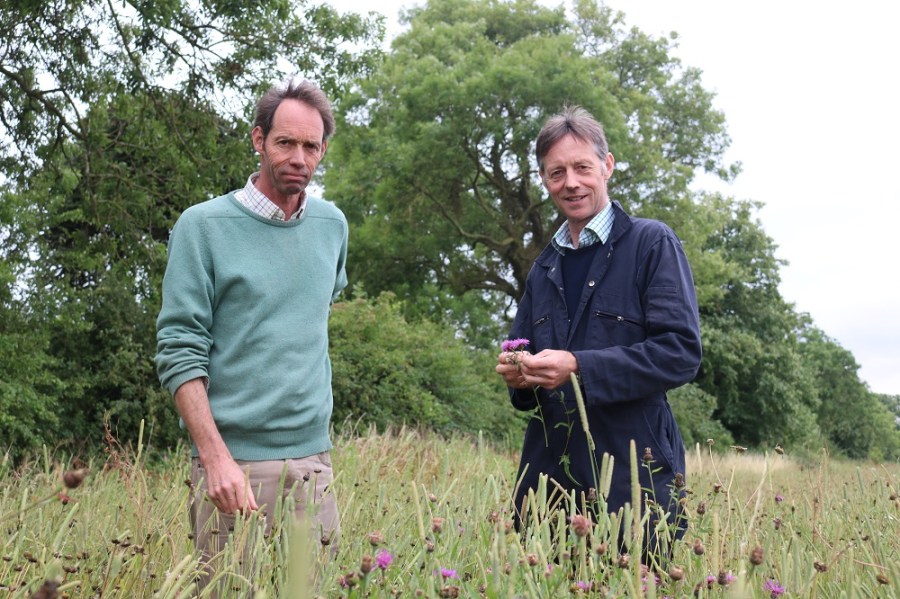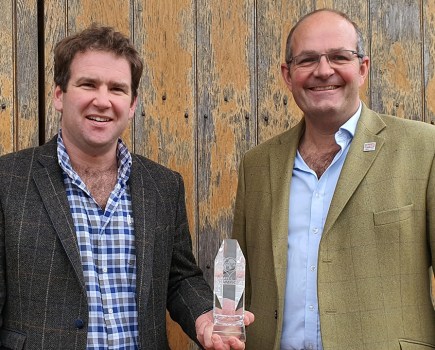William (left) and Andrew Pitts
A farm in Northants has not only achieved measured success in its quest to boost biodiversity and reduce its carbon footprint, it’s been a demonstration site for policy-makers. CPM finds out.
It’s in their DNA to look after the farm’s biodiversity. That’s a very compelling story.
By Tom Allen-Stevens
One day in spring 2012, a number of key figures in environmental policy met at The Grange, Mears Ashby, Northants, to discuss plans for a new Countryside Stewardship (CS) scheme.
“It was one of those beautiful spring mornings when the birdsong was almost deafening,” recalls Andrew Pitts, who with his brother William farms at The Grange and hosted this important gathering. Among those looking round their farm were heads of NFU, CLA, Natural England, Environment Agency, RSPB, Game and Wildlife Conservation Trust, Crop Protection Association and the then Defra farming minster.

Work to increase farmland numbers at The Grange demonstrates how commercial farming complements, rather than conflicts with the environment.
“We were asked how we achieve the bird numbers we have, so we showed them the supplementary feed rides we provide. We explained the variety of seed grains we put down to keep birds fed during the hungry gap, the evidence of this, and how it had influenced the bird counts we’d recorded in recent years,” continues Andrew.
“It formed the basis for AB12 in the Mid Tier CS scheme – supplementary winter feeding for farmland birds. Today there must be 1000s of tonnes of seed farmers across the UK provide as a consequence to sustain farmland birds over that crucial period before nesting begins.”
Andrew has a deep-seated passion for commercial farming and how it complements, rather than conflicts with the environment in which it operates. “The key is balance,” he stresses. “I get so frustrated with single-issue pressure groups who claim productive farming harms wildlife. We’ve shown it doesn’t and we have the data to prove it.”
This process of gathering the evidence started in 2002 and was led by BASF. “We have sustainability goals that chime with how a great many UK progressive farmers run their arable businesses,” notes BASF agricultural sustainability manager Mike Green. “So we started working with the Hinchliffe family at Rawcliffe Bridge in Yorks, taking bird counts as well as insect and other assessments of monitor species.
“Andrew and William have the same, sustainable approach to farming that balances today’s economics with the long-term benefits for the farm. Andrew’s a keen and vocal advocate and The Grange also offered a farm closer to London, with the opportunity to engage key policy makers, so we started working together in 2009. BASF funds the monitoring work, but it’s carried out by independent scientists who lead in this field. Over the two UK sites we’ve gathered a valuable dataset that represents £1.4M of assessments to date.”
The two farms are part of a pan-European network operated by BASF and Mike believes this is an effective way to bring positive change with benefits for the farming economy, the environment and wider society. “At the centre of it are farmers like Andrew and William who understand the value of soil to their business –it’s in their DNA to look after the farm’s biodiversity. That’s a very compelling story, and we want to help them tell it to the right people.”
So the farm’s had over 2500 visitors since the relationship began. But it’s not about numbers – groups have varied from national leaders to local interest groups, schoolchildren to scientists. “Perhaps the most interesting visits were when we showed the pollen and nectar areas to a group from Northants County Council and then to some engineers from the Jaguar Landrover factory,” recalls Andrew. “One visit resulted in better managed, flower-rich roundabouts and grass verges, while at the car factory they planted a meadow which was found to have a positive effect on well-being for the staff.”
Now the focus of work at The Grange is on climate change. Andrew and William have set up a number of on-farm trials and demonstrations that reflect some of the practices they pursue across the 800ha they farm.
An example is the agroforestry plot. “We’ve planted fruit trees in 6m strips within the field, placed 24m apart – the width of our tramlines,” explains Andrew. “We want to see how production is affected by the trees, compared with a conventional arable field, but we’re also monitoring beneficial insects, and the opportunity to reduce inputs.”
The trees don’t just capture carbon – Andrew’s working with a local cider-maker and has plans to harvest the crop in years to come. They also plan to plant further apple trees in some redundant land around a 5MW solar array that now occupies part of the farm.
There’s another trial with different types of willow and miscanthus grown in 3x25m plots. “We’re interested to know how these crops can best be grown for biomass, but also how their management affects local wildlife,” notes Andrew.
There’s good reason – some of the farm’s woodland is home to the wood white butterfly, a rare and protected species he’s keen to encourage. “The scalloped coppicing we’ve now adopted has been shown to be beneficial. It could have implications for hedgerow management for other endangered species.”
Carbon sequestration with wildlife spin-offs accurately sums up Andrew’s approach to balance across the productive arable areas of the farm, too. With soils that vary from ironstone silty sands to Hanslope series chalky boulder clay, wheat yields average 10.1t/ha. Imports of compost, FYM and chicken manure total around 3000-4000t/yr and have been steadily improving soil organic matter from a range of 2.5-3.1% in 2005 to 5.8-7.5% currently.
Sheep and cover crops have been introduced to take this a step further. “We’ve done some trials looking at worm counts of different over-wintered options,” Andrew reports. “We found eight worms per spadeful in wheat stubble. Oats and phacelia cover crop delivered 12-14 while sheep on stubble turnips performed best at 18-20 worms per spadeful.”
Their farming system has now been adopted over some land taken on that was previous farmed organically. “I expected to find really low P&K indices and a good soil structure, but was staggered to find the complete opposite. Plenty of muck had kept nutrient indices healthy, but continued working of the soils had knackered the structure – put a spade into it and it smelt bad. Now, within our conventional system, the structure and worm life have improved significantly. Wheat yields have increased from 7.1t/ha in the first year we farmed it conventionally and are now in line with the farm average.”
This reflects a policy of reduced cultivations taken across the farm. Ploughing ceased in 2006, replaced with a Challenger and Väderstad TopDown. “We’ve gradually reduced the depth of cultivations until 2014 when we started direct drilling with a John Deere 750A. The cost savings through selling the Challenger and associated kit amount to £53,000/yr with fuel use alone falling from 78 l/ha to just 37 l/ha.”
But in line with other changes, it’s been a measured reduction – Andrew’s kept his focus firmly on maintaining production, while on-farm establishment trials and monitoring have ensured they’ve been in harmony with his soils. “By far the most important tool on the farm is the spade,” he states.
That may be the case, but he’s not shy of using technology. There’s been a considerable investment in recent years into precision and telemetry extras that have been introduced into replacement machinery to protect £130,000 worth of grain premiums, including on the Claas Lexion 780 combine. “These have more than paid for themselves and really allowed us to boost efficiency of the harvesting operation. That means a better premium for our quality crop, while we now know through Claas Telematics that we’re running one of the most efficient monitored combines in the country, with a fuel use of less than one litre per tonne of crop.”
Not every acre’s cropped, however. While other farmers have used precision farming kit to even out their crops, Andrew’s used it to benchmark. “We’ve been using the Omnia platform to analyse the in-field performance. You can quickly identify areas, such as headlands that drag down the field average.”
On one field, for example, Andrew identified areas where the cost of production was over £300/t, reducing the profit over the whole field to £4.51/t. Taking out the turning areas and headlands – 20% of the area – increased profitability to £16.29/t. “Those areas have now been planted to stewardship margins – a great source of food for birds and a habitat for beneficial insects, as well as capturing carbon.
“What we’re now aiming to do is focus input use on the more productive areas of the field to determine how we can boost this further. It’s a journey we’ve just started on, and I’m expecting platforms such as xarvio to help identify how we can target inputs better. This is a really exciting time for technologies in agriculture with a whole host of promising tools currently going through their paces.”
The land Andrew farms at nearby Whiston is the testbed for Hutchinsons’ Helix project looking at areas such as climate and pest prediction, nutrition technology, variety trait work and environmental sustainability. Findings from the farm will help inform how other farmers can get the best use from the technologies on offer.
“Just look at nitrogen fertiliser, for example – it’s 50-60% efficient, which represents huge scope for improvement. We’ve moved to liquid and now use Limus N-inhibitor which has seen improvements in efficiency of 5-10%. I’m convinced the technologies are available that will provide the route to further improvements – it’s just a question of applying the science in the field and sharing what we learn,” says Andrew.
“A more balanced approach is not about beating people over the head, pointing fingers or imposing limits. A thriving rural economy is the best way for the countryside to develop and deliver a long-term future for farming. All we’re doing is testing things over time, gathering evidence on what works best for us and quietly influencing to ensure all British farmers can benefit.”
What makes Andrew Pitts a Climate Change Champion?
Innovative ideas
It’s not just the zest for trying out different approaches, but the rigour with which they’re tested and the influential routes through which the results are shared that position Andrew as a true thought leader. The success lies in how this approach balances the economics of commercial farming with care for the long term future of the farm.
Productivity push
A dogged pursuit of improving productivity has been at the forefront of changes made at The Grange. Andrew has harnessed the best technology farming has to offer and is trialling emerging innovations in a quest to push more, sustainably from limited resources.
Cultivation care
A gradual reduction in cultivations has gone hand-in-hand with measures to build soil organic matter. Every step of the way has been tested through on-farm trials and monitored with the trusty spade. Trials and demonstrations are exploring the best ways to capture carbon with trees and agroforestry.
Bio-based boldness
Aside from The Grange’s solar farm and biomass enterprises, Andrew proactively seeks out new ways to harness natural resources that not only sequester carbon but benefit local wildlife.
Honest advocacy is a powerful prompt
Productive agriculture needs a healthy environment but a growing world population with evolving expectations needs farmers to produce more food. How do farmers meet these apparently conflicting objectives and simultaneously address the challenge of climate change?
“In our experience, farmers are remarkably proficient at sustainably growing their businesses,” says Mike Green at BASF. “We’ve developed a tool called AgBalance that allows them to review their sustainability contribution – the only one that assesses the balance of economic success, environmental protection and social responsibility.
“But we come across admirable examples of this throughout the BASF Farm Network – a rich community of more than 25 partner organisations in seven countries across Europe and with members of our Real Results circle,” he says.
“Farms like The Grange provide a neutral place where people from all walks of life can explore the different aspects, views and desires of farming and food production. The essential element is that what they see is built on robust evidence, independently gathered.”
For Mike, what Andrew provides through The Grange are not just good examples of how farming is meeting its Net Zero objectives. “He projects these from a position of authority, based on evidence, experience, passion and truth. It’s a compelling case he confidently takes to the highest authority in pursuit of positive change, which is why BASF is pleased to support his nomination as Climate Change Champion 2020.”
Climate Change Champions
UK Farming has set itself the challenging target of Net Zero emissions by 2040. Although led by the NFU, it will take the entire industry, working together in a partnership approach to meet this ambitious goal.
But there are individual growers, thought leaders who have already started on this journey. They have the ideas, the progressive outlook and the determination to shape positive change. CPM has teamed up with leading agricultural suppliers who have a credible Net Zero aspiration to identify these individuals and bring them into the top-level discussion about how farming can position itself as the solution to climate change. CPM readers will get the chance later this year to decide who will be awarded the accolade of Climate Change Champion 2020.




